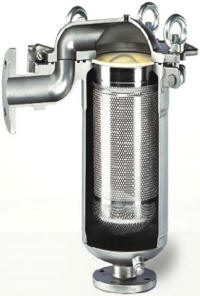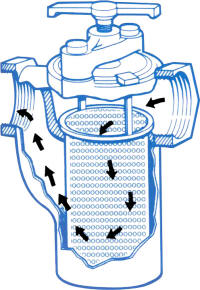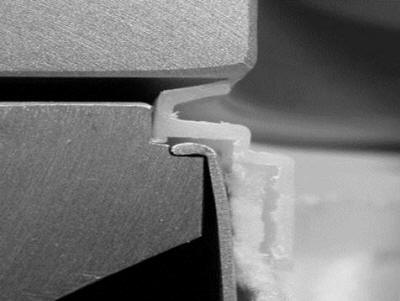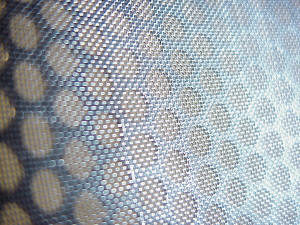Strainers vs. Filters
Difference between strainers and filters are the level of retention and efficiency of media
A general definition for industrial filtration is the separation of solids from fluids (which can be a liquid or gas) to enhance the downstream process in some way. Most applications are readily identifiable as either having retention requirements of "coarse" (strainer) or "fine" (filter), however there is a "gray area" of overlap where either can be used. This article identifies criteria to guide your selection for those applications.
Determine the Particle Size to Retain
 This will be defined by your process and the equipment downstream; we
typically suggest retaining a particle size equivalent to 33% to 50% of the
maximum allowable particle size. The reasoning behind this practice is
that sometimes multiple small particles will collide together and form a larger
particle, (especially in areas of low velocity within the pipeline) thus
targeting a smaller size particle helps minimize that occurrence. Particle
characteristics such as shape, deformability and volume as a percentage of the
fluid also need to be considered. The more conservative you are by using a
finer retention increases the complexity (and thus cost) of the housing and
element.
This will be defined by your process and the equipment downstream; we
typically suggest retaining a particle size equivalent to 33% to 50% of the
maximum allowable particle size. The reasoning behind this practice is
that sometimes multiple small particles will collide together and form a larger
particle, (especially in areas of low velocity within the pipeline) thus
targeting a smaller size particle helps minimize that occurrence. Particle
characteristics such as shape, deformability and volume as a percentage of the
fluid also need to be considered. The more conservative you are by using a
finer retention increases the complexity (and thus cost) of the housing and
element.
 Straining or Filtering?
Straining or Filtering?
Most pipeline strainers can be supplied with mesh lined perforated screens
for particle size retentions as low as 400 mesh (approximately 38 microns); like
many things in life, "just because you can, doesn't mean you should"!
Strainers are designed for relatively "large" particle sizes and we adhere
to the guideline that strainers are best used for particles you can see with
your eyes, which tends to be particles larger than 50 microns. However,
since filters are also used within this range, we start looking at filters for
retaining particles finer than 150 microns because with finer retention there is
often a requirement for increased efficiency.
Nominal vs Absolute Retention
All filtration retentions are considered nominal unless otherwise
specified and it infers approximate whereas absolute infers 99% or
greater efficiency for the specified retention.
The element design for most pipeline strainers do not have a sealing
capability to ensure retentions much lower than 100 mesh (approximately 150
microns), so if your process is so critical that you need to retain particles
finer than 100 mesh, you should consider a "filter".
 Even with filter cartridges and filter bags, which provide depth
filtration, nominal rated media relies on a "cake" of particulate to
increase the retention efficiency. Thus, there are both media and vessel
design characteristics contributing to the overall retention efficiency.
Even with filter cartridges and filter bags, which provide depth
filtration, nominal rated media relies on a "cake" of particulate to
increase the retention efficiency. Thus, there are both media and vessel
design characteristics contributing to the overall retention efficiency.
The terminologies of "absolute" and "nominal" retentions are described in
detail in our
Filtration Efficiency Article.
Filtration Ratio
The ratio of the inlet pipe area to the element surface area is an
important characteristic to consider, especially for applications requiring
retention of particles within the 100 and 200 micron range in which either a
pipeline strainer or filter could be employed. It is tempting to utilize a
pipeline strainer because they typically cost less than a filter due to the
simplicity of their design.

Filters utilizing a cartridge (alloy or non-alloy) or cloth material not
only provide surface filtration, but also provide depth filtration. These
engineered materials have layers which offer progressively finer retention, thus
increasing both efficiency and solids holding.
Situations where the fluid normally has few solids and the filtration
device is protecting the downstream process from an upset condition, a pipeline
strainer might be acceptable even for particles <100 microns.
When there is an expectation of continuous particle removal or if a
few larger particles bypassing the filtration device would cause a
problem downstream, then the complexity of a filter is justified
Commonalities of Strainers and Filters
The difference between the two terms is really the underlying complexity
of the design, with filters tending to be more complex and thus more expensive.
Filtration experts have visited and worked with engineers, plant managers
and production personnel from various industries and can often visualize the
most appropriate design for your specific application given some basic design
criteria.
The following information is required to help ensure the most appropriate
design is selected:
-
Common fluid name
-
Particle size to remove
-
Estimated concentration, PPM
-
Describe the solids to be removed
-
Specify the maximum flow rate, pressure and fluid temperature
-
Advise the inlet and outlet pipeline size, connections and material of construction
-
Can your process be interrupted for element cleaning or replacement?
-
Perhaps most importantly, an overview of your application including the problem you are trying to solve and if you have any special requirements which might include special coatings, documentation or NDT procedures
Our goal is to help you solve your application in the most cost effective and reliable manner possible, let our 25+ years of experience go to work for you today!



